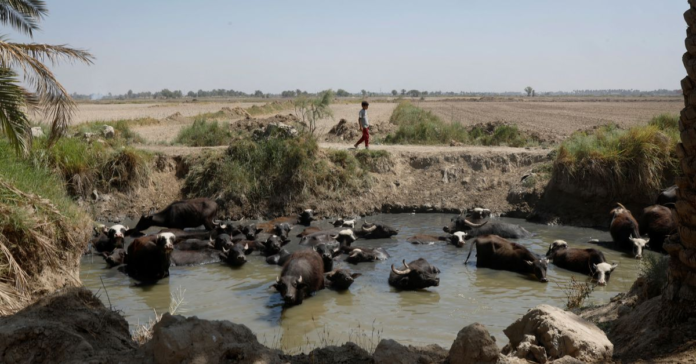Summary Photo essay: bit.ly/3OkLDpm
NAJAF, IRAQ, July 20 (Reuters) – Petting a water buffalo before tying a fodder bag around its neck, Mustafa Ahmed tends his father’s herd in Iraq’s southern province of Najaf where his family have raised animals for generations but lack of water now threatens their livelihood.
Iraq forms part of the “Fertile Crescent”, land sweeping from the Mediterranean to the Persian Gulf which has been farmed for thousands of years. But the landscape has been devastated by upstream damming of Iraq’s two main rivers, the Tigris and the Euphrates, lower rainfall trends and decades of conflict.
Ahmed’s father, Ahmed Abdul Hussein, said the dire water shortage in their home Al-Mishkhab district is forcing him to sell their animals one by one – heartbreaking for his son.
They recently lost a two-month-old calf. “It hurts that one of them died… I really love them”, the 13-year-old said. “Now we have nine left.”
Last year they had 20.
Reuters spoke to six families of herders in Najaf province who all said they have had to sell animals or have had livestock die over the last months.
In the nearby district of Umm Khashm, the number of water buffalo decreased from 15,000 to 9,000 over five years, said local mayor, Meshtaq Sebar.
Khaled Shemal, a spokesman for Iraq’s ministry of water resources, said Najaf province only received around 40% of its traditional share of water this year.
The situation is even worse in Iraq’s southern marshes which were already in a fragile state and are now experiencing the most severe heat wave of the last 40 years. Almost 70% of the marshes are devoid of water, according to the United Nations Food and Agriculture Organization (FAO).
Shemal said water flows on the Euphrates and Tigris rivers have decreased by about 70% this year compared to previous decades.
Officials and experts cite upstream damming in Turkey and Iran, climate change, outdated domestic irrigation techniques and a lack of long-term management plans as the root causes of a water crisis that is driving thousands out of the countryside.
In Al-Mishkhab the landscape has become barren and Abdul Hussein’s animals must brave the dust blowing from abandoned farmland with scant water to keep cool.
“This water is stale” said Abdul Hussein, pointing at his animals standing in stagnant water. “They are suffering from thirst”.
Poor water quality affects the animals’ health and weakens their immune system.
[1/22]Mustafa Ahmed, 13, keeps watch over his family’s buffalo herd as they wade at a waterhole in the Al-Mishkhab district, on the outskirts of Najaf, Iraq, June 23, 2023. Ahmed’s father, Ahmed Abdul Hussein, said he took his sons out of school years ago, to help him with the herd. “I regret this more… Read more
Nadhir Al-Ansari, professor at Sweden’s Lulea University of Technology, said the water quality in Najaf is amongst the poorest in Iraq. Untreated wastewater and chemical fertilizers dumped into the river upstream make the water increasingly unfit for consumption as it flows down south, he said.
As water levels drop the salinity of the water increases beyond a point recommended for human consumption, he added.
FARMING RAVAGED
In addition to the lack of water, a drastic decline in crop production and a rise in the price of fodder has left farmers struggling to feed water buffalo.
According to the FAO, across Iraq only about half of the land cultivated in 2020 is now being tended. In Najaf province, the situation is even more extreme – only 5 percent of 2020’s growing area is being used after rice planting was almost completely halted due to lack of water.
Herders like Abdul Hussein used to farm patches of land themselves, or source cheap fodder from rice farmers.
“When the buffalo doesn’t eat… it does not produce milk,” said Abdul Hussein, adding his income had shrivelled without his main source of earnings, and he struggles to afford the now much more expensive, often imported, fodder.
“A few more months and it might all be over,” he said, as the sun set over al-Mishkhab. The only alternative is to move to the outskirts of Najaf, where the rest of his family are, to have access to drinking water, he said.
The International Organization for Migration (IMO) says that as of last year, 62,000 people had been displaced across Iraq due to drought. Many moved from the countryside to cities with high unemployment rates and poor services.
Iraq needs adaption strategies, said Ally-Raza Qureshi, the U.N. World Food Programme’s local representative. So far, Baghdad has used oil revenues to avoid a hunger crisis but “these safety nets do not cover for livelihood loss”, he added.
Seated in a sparsely furnished living room, Abdul Hussein
said he took his sons out of school years ago, to help him with the herd. “I regret this more than anything”, he added.
About 7% of minors aged 5–17 years are engaged in child labour in Iraq, according to UNICEF.
Ahmed said he wanted to go back to school after seeing his animals disappear one by one. As he does not know how to read or write, his father fears his future prospects are slim.
“The fate of our lifestyle is unknown. We don’t know what lies ahead,” said Abdul Hussein.
Reporting by Ahmed Saeed and Charlotte Bruneau; Writing by Charlotte Bruneau, Editing by Alexandra Hudson
Our Standards: The Thomson Reuters Trust Principles.



